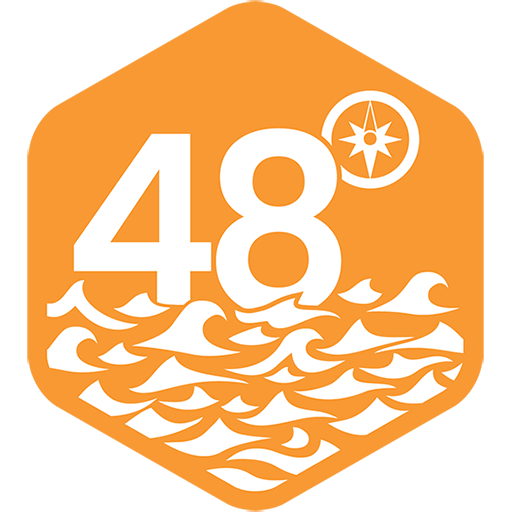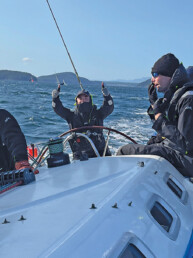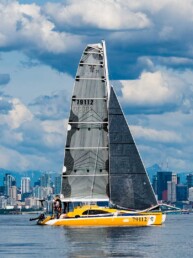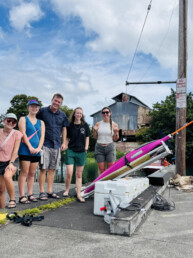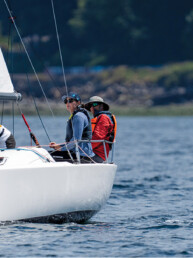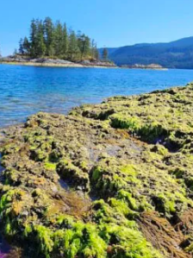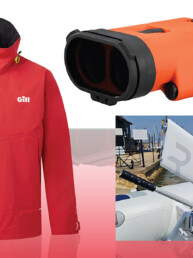From the August 2020 issue of 48° North
Shantyboat legend, Harlan Hubbard, once wrote of yearning to settle down in “some backcountry beyond the road’s end, long ago abandoned or passed over by the expanding world, a second-growth wilderness where undisturbed we could participate in a celebration of the earth and its seasons.”
If I didn’t know that Hubbard was a denizen of the Ohio and Mississippi Rivers, I would have assumed he was referring to the Lower Columbia River Estuary. A miles-wide expanse of marshy islands and rain-soaked settlements sandwiched between the working forests of Oregon and Washington, this watery area is a definite has-been. Gone are its once vast salmon runs and busy canneries, vanished are the huge trees whose timber kept mills humming; and the furs that once made fortunes are no longer hot commodities.
Still, nature happens: vegetation and wildlife spring back, the river sends fresh mountain water downstream, the tides rise and fall. Like Hubbard, I search for solace in this passed-over land, so rich in life and history. But instead of settling down here, I wander by small boat.
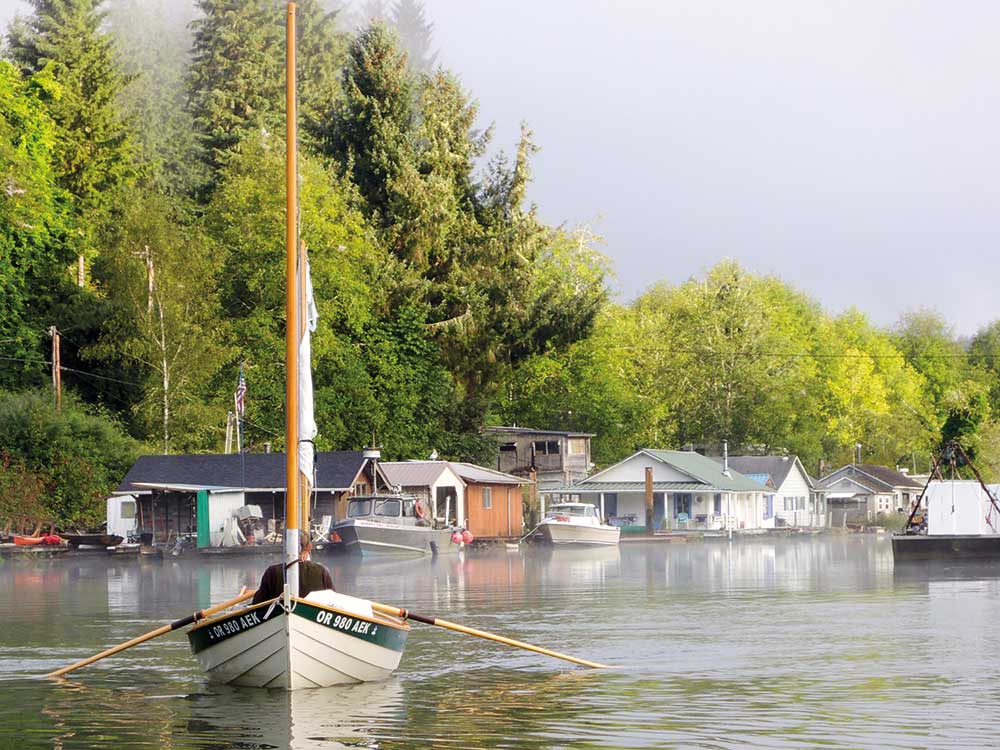 On my last voyage, I circumnavigated the Lewis & Clark and Julia Butler Hansen National Wildlife Refuges. Their 39,000 acres of marsh, islands, and open water are mostly accessible only by boat—which is just the way I like it. Describing the area, the refuge brochure captures an essential process in the estuary: “Twice a day the islands are part of the land, and twice they are reclaimed by the water as rising tides reverse the river’s current.”
On my last voyage, I circumnavigated the Lewis & Clark and Julia Butler Hansen National Wildlife Refuges. Their 39,000 acres of marsh, islands, and open water are mostly accessible only by boat—which is just the way I like it. Describing the area, the refuge brochure captures an essential process in the estuary: “Twice a day the islands are part of the land, and twice they are reclaimed by the water as rising tides reverse the river’s current.”
I got a late start, departing around 4:00 p.m. from Cathlamet, Washington, a rustic, small town about 30 miles upriver from the Pacific. Checking for ships, I scooted across the mainstem of the Columbia into Clifton Channel, bound to the south by a steep forested bluff and the north by the marshy upstream edge of the refuge, Tenasillahe Island. The afternoon inflow wind from the sea was funneling off the bluff and colliding with an outgoing tide, making for slow, splashy sailing as I headed west.
Atop a battered wooden pier on the south shore sat the old Clifton cannery building, its faded brick-red paint hinting at a bright past. But now, as daylight was dwindling, the shadows dominated and the structure’s future seemed uncertain. With waves building over shallow water, sailing was no longer fun, so I dropped sail, pulled out my oars and glided into a slough, where the shallow water was disturbed by only a few ripples. In the distance, a lone duck hunting shack was the only indication of human presence. Despite the howling wind a few hundred feet away, I felt calm here in the thin, murky water. It seemed a tranquil spot to spend the night, so I tossed out an anchor and unrolled my cockpit tent.
The clouds were so thick in the morning that no sunrise was visible, just a slight brightening in the sky. Slowly, evergreen-studded hills emerged in the distance, and the Sitka spruce and emergent grasses on the islands became distinct. Soon a light wind arose, just enough to sail at about two knots, the perfect speed for watching cormorants, osprey, and otters chasing after fish.
Charts exist for these backwaters, with interesting but troubling notes like, “Prairie Channel is subject to frequent changes.” Small boaters like me, without electronics, have to use their best judgment. I commonly found myself in such shallow water that my centerboard scraped the bottom. Worse, on more than one occasion, in seemingly open water, the whole boat ground to a halt. During one of these incidents, I could see that I was in only six inches of water. Holding onto the painter, I stepped out of the boat to examine my situation. It was unsettling to see Row Bird afloat, unmanned, and completely surrounded by water. With cautious footwork and a little shoving, I got her back into deeper water.
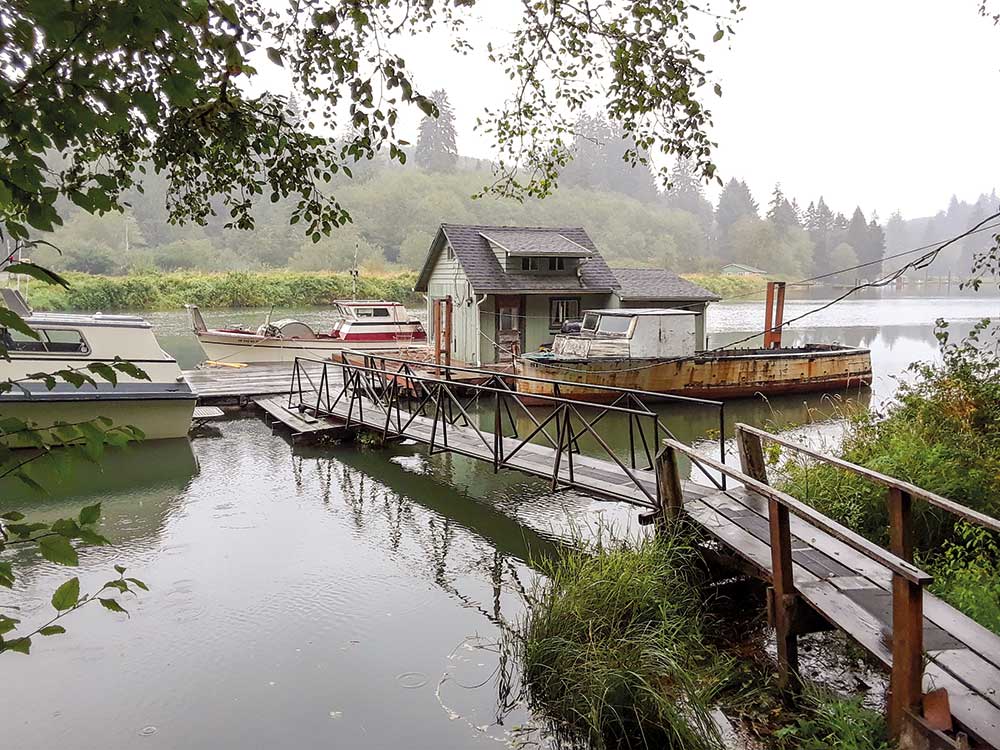 Along the forested mainland shore ran the remains of an old railroad, its tracks periodically emerging from the forest. A few settlements appeared now and then, small clusters of houses in varying states of repair, some long abandoned and slowly sinking back into the marsh. But these remnants of human habitation were few in a landscape populated mostly by willow trees and marshy islands, their grasses resembling overgrown lawns partially submerged in water.
Along the forested mainland shore ran the remains of an old railroad, its tracks periodically emerging from the forest. A few settlements appeared now and then, small clusters of houses in varying states of repair, some long abandoned and slowly sinking back into the marsh. But these remnants of human habitation were few in a landscape populated mostly by willow trees and marshy islands, their grasses resembling overgrown lawns partially submerged in water.
Near the western edge of the refuge, I sailed over a sea of grass, the water so shallow that I used a canoe paddle as a rudder. When I reached the John Day River, I navigated around a railroad swing bridge, abandoned partially open, and headed upstream to visit an old friend who lives in a village of floating cabins dating back to the 1930s.
The scene was vibrant, compared to the wildlife refuge, where I’d only seen two boats all day. People sat on waterside porches or tended to chores around their homes or hideouts. Tied to the docks were generations of commercial fishing boats ranging from aluminum gillnetters to old wooden bow-pickers, as well as pleasure craft of all sorts.
The next morning, I headed back upriver and skirted the north edge of the refuge, where the dredged mainstem meets the marsh. Tankers, bulk carriers, and large cruising boats plowed steadily through the water here, which was deep and as well marked as a highway. A nearby buoy leaned seaward with a trailing wake, indicating the direction of the tide. I could not row against it and, finding no wind, I pulled out my binoculars to observe a flock of white pelicans paddle in a tranquil inlet. Ashore, several sat awkwardly on a slight rise, along with a few herons.
As the day warmed, an afternoon breeze blew upriver. Trading my oars for sail, I headed for the town of Skamokawa, Washington. Founded before any roads served the area, its Victorian-era homes face a network of streams and sloughs. I stopped to talk to a resident about a quiet place to spend the night and was directed upstream. “You can anchor out just past the old net shed,” he advised, as if everyone knew this landmark. The shed was easy to find behind some old pilings, saplings emerging from their rotten tops. Aside from the ruckus emerging from a nearby osprey nest and the call of a coyote, it was a silent night.
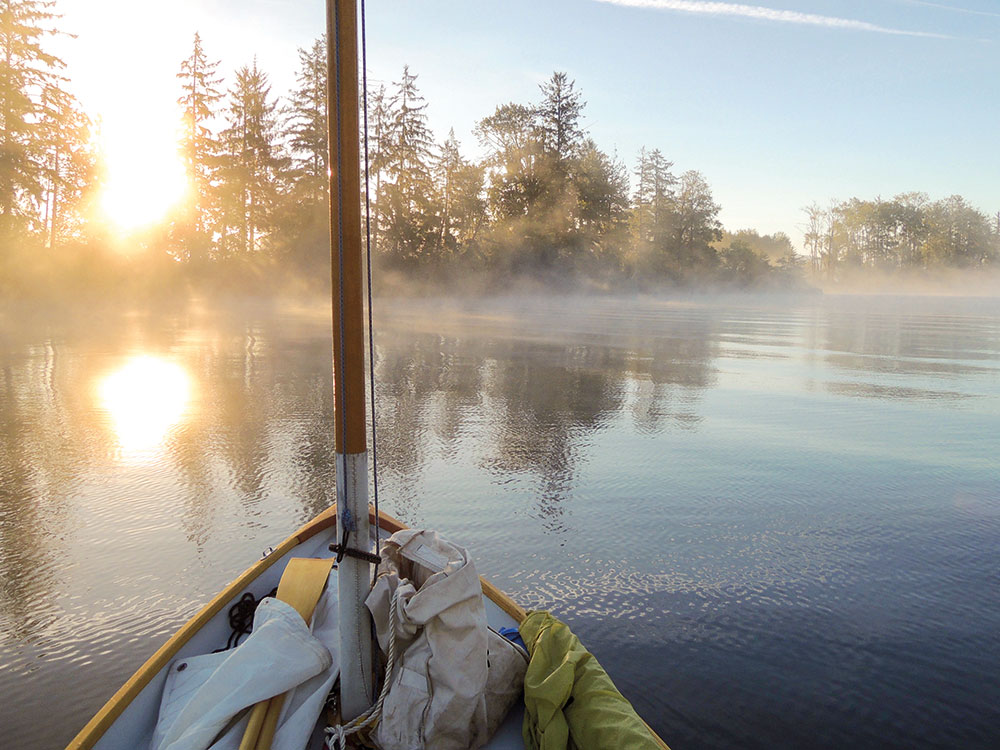
At dawn, I was awoken by a chilly breeze and a flickering light. Curious, I pulled back the flaps of my cockpit tent to watch the sun pierce the trees on a nearby island. Above, quickly moving drifts of fog were illuminated with rays of light, like a Biblical painting. Skamokawa was the native people’s word for “smoke on water”; and now, watching the play of fog and light on the river, I couldn’t think of a more appropriate name for the place.
In search of the elusive Columbian white-tailed deer, I spent the rest of the day slowly sailing and rowing upstream through the maze of islands of the Julia Butler Hansen portion of the refuge, where the animals shelter. None were to be found, but I was content to explore the calm channels, with their birds and the occasional aquatic wildflower meadow.
It was my last day out, and I wasn’t excited about going home. Observing the slow reclaiming by nature of human-made structures made me wonder what my own neighborhood might look like in 100 years. Would Portland still be a thriving town, or would the forest predominate again?
For now, that didn’t matter, I refocused my mind on the winding slough ahead of me, appreciating the second growth wilderness and the human stories that had shaped it. This journey was almost over, but I’d be back to celebrate the seasons here again, to explore the thin waters, to linger in the marsh, and to ponder the turning of the tide.
Bruce Bateau
Bruce Bateau sails and rows traditional boats with a modern twist in Portland, Ore. His stories and adventures can be found at www.terrapintales.wordpress.com
